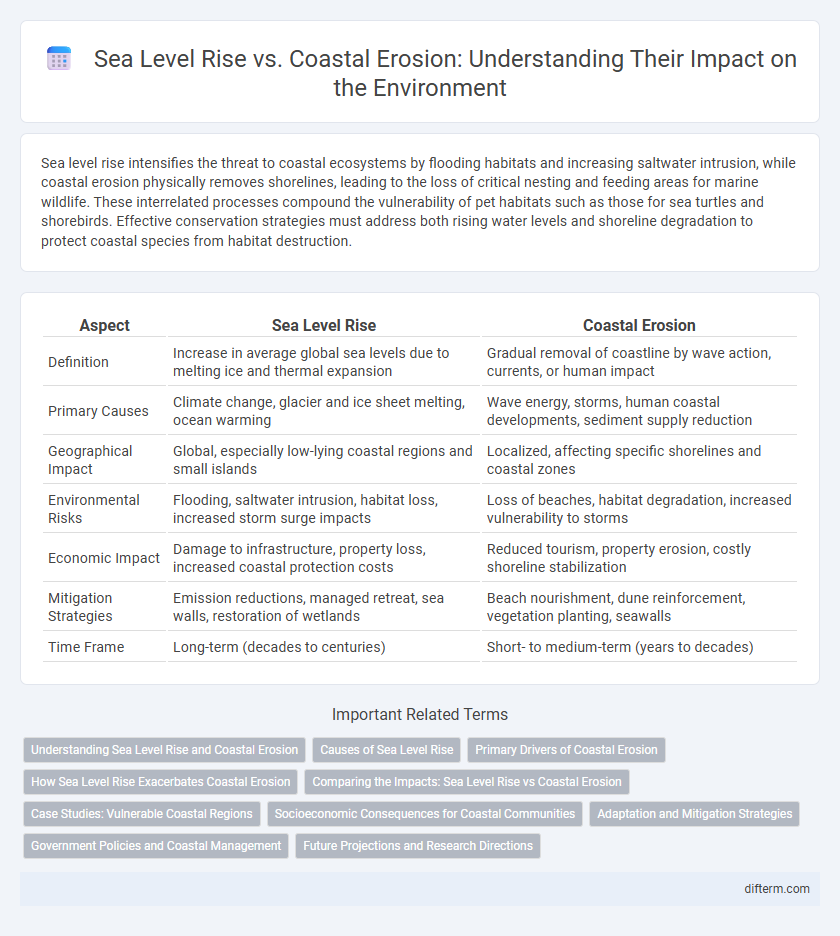Sea level rise intensifies the threat to coastal ecosystems by flooding habitats and increasing saltwater intrusion, while coastal erosion physically removes shorelines, leading to the loss of critical nesting and feeding areas for marine wildlife. These interrelated processes compound the vulnerability of pet habitats such as those for sea turtles and shorebirds. Effective conservation strategies must address both rising water levels and shoreline degradation to protect coastal species from habitat destruction.
Table of Comparison
| Aspect | Sea Level Rise | Coastal Erosion |
|---|---|---|
| Definition | Increase in average global sea levels due to melting ice and thermal expansion | Gradual removal of coastline by wave action, currents, or human impact |
| Primary Causes | Climate change, glacier and ice sheet melting, ocean warming | Wave energy, storms, human coastal developments, sediment supply reduction |
| Geographical Impact | Global, especially low-lying coastal regions and small islands | Localized, affecting specific shorelines and coastal zones |
| Environmental Risks | Flooding, saltwater intrusion, habitat loss, increased storm surge impacts | Loss of beaches, habitat degradation, increased vulnerability to storms |
| Economic Impact | Damage to infrastructure, property loss, increased coastal protection costs | Reduced tourism, property erosion, costly shoreline stabilization |
| Mitigation Strategies | Emission reductions, managed retreat, sea walls, restoration of wetlands | Beach nourishment, dune reinforcement, vegetation planting, seawalls |
| Time Frame | Long-term (decades to centuries) | Short- to medium-term (years to decades) |
Understanding Sea Level Rise and Coastal Erosion
Sea level rise intensifies coastal erosion by increasing the frequency and intensity of wave action against shorelines, accelerating the loss of land. Understanding the interplay between rising sea levels and coastal erosion involves analyzing tidal patterns, sediment transport, and human activities that alter natural barriers. Monitoring these dynamics through satellite data and coastal sensors is essential for effective shoreline management and mitigation strategies.
Causes of Sea Level Rise
Sea level rise is primarily caused by thermal expansion of seawater as global temperatures increase and the melting of glaciers and polar ice caps due to climate change. The influx of freshwater from melting ice sheets in Greenland and Antarctica significantly raises ocean volumes. Human activities such as fossil fuel burning intensify greenhouse gas emissions, accelerating global warming and contributing to these processes.
Primary Drivers of Coastal Erosion
Primary drivers of coastal erosion include wave action, storm surges, and tidal currents, which continuously reshape shorelines and contribute to sediment displacement. Sea level rise exacerbates these processes by increasing the frequency and intensity of flooding and storm impacts on coastlines. Human activities such as coastal development and sand mining further weaken natural barriers, accelerating erosion rates.
How Sea Level Rise Exacerbates Coastal Erosion
Sea level rise accelerates coastal erosion by increasing the frequency and intensity of wave action along shorelines, leading to the rapid loss of beaches and cliffs. Higher sea levels enable storm surges to penetrate further inland, eroding protective dunes and natural barriers that stabilize coastlines. This process not only reshapes coastal ecosystems but also threatens human infrastructure and habitats with increased vulnerability to flooding and land loss.
Comparing the Impacts: Sea Level Rise vs Coastal Erosion
Sea level rise intensifies coastal flooding, submerging low-lying areas and threatening freshwater resources, while coastal erosion directly removes landmass, damaging habitats and infrastructure. The accelerated pace of sea level rise exacerbates erosion by increasing wave energy and storm surge impacts along shorelines. Both phenomena synergistically degrade coastal ecosystems and complicate management strategies for protecting vulnerable communities.
Case Studies: Vulnerable Coastal Regions
In Bangladesh's Sundarbans, rising sea levels have exacerbated coastal erosion, threatening critical mangrove habitats and displacing vulnerable communities. The Chesapeake Bay in the United States faces combined risks as higher sea levels accelerate shoreline retreat, impacting wetlands and biodiversity. In the Mekong Delta, Vietnam, intensified erosion linked to sea level rise undermines agricultural lands and increases flood susceptibility for millions.
Socioeconomic Consequences for Coastal Communities
Sea level rise intensifies flooding and salinization, threatening freshwater resources and agriculture vital for coastal economies. Coastal erosion accelerates the loss of habitable land, damaging infrastructure and reducing property values, leading to displacement and increased poverty risks. Together, these processes strain local governments' capacity to provide essential services, undermining community resilience and long-term economic stability.
Adaptation and Mitigation Strategies
Adaptation strategies to address sea level rise and coastal erosion include constructing seawalls, restoring mangroves, and implementing managed retreat to reduce community vulnerability. Mitigation efforts emphasize reducing greenhouse gas emissions through renewable energy adoption and carbon sequestration to slow climate change impacts driving sea level rise. Integrated coastal zone management optimizes both adaptation and mitigation by balancing ecological preservation with sustainable human development.
Government Policies and Coastal Management
Government policies addressing sea level rise and coastal erosion emphasize adaptive management strategies such as the implementation of setback zones, restoration of natural barriers like mangroves and dunes, and investment in resilient infrastructure. Coastal management plans integrate climate modeling data to prioritize areas at highest risk, balancing ecological preservation with urban development. Enhanced monitoring systems and community engagement initiatives support the enforcement of regulations designed to mitigate the impacts of rising seas and prevent land loss along vulnerable shorelines.
Future Projections and Research Directions
Future projections indicate sea level rise will exacerbate coastal erosion rates, threatening ecosystems and human settlements globally. Research focuses on improving predictive models by integrating climate change scenarios, sediment dynamics, and human intervention impacts. Emerging studies emphasize adaptive coastal management strategies to mitigate combined effects of rising seas and accelerating erosion.
sea level rise vs coastal erosion Infographic

 difterm.com
difterm.com